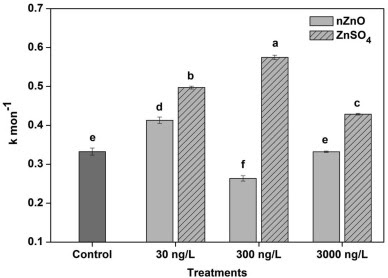By: Melissa Garcia
There is an ecotoxicological risk of zinc oxide nanoparticles (nZnO) in freshwater ecosystems. The toxicity from these nanoparticles can be attributed to release of ionic Zn, increase in oxidative stress, and its physiochemical properties. To understand the containments effect on aquatic fungi, researchers examined leaf litter decomposition, an important degradable nutrient in ecosystems. The study explored the rate of decomposition in leaf litter after exposed to nZnO and ZnSO4 in different environmental concentrations using a microcosm with artificial reconstituted fresh water (ARFW) along with a control microcosm. Scientists also explored the litters chemical components, changes of ionic Zn concentration, enzyme activity, fungal community and fungal biomass after exposure. Results demonstrated an increase of ionic Zn concentration over a 45 day exposure in ARFW with nZnO, and contrastingly a decrease of ionic concentration in ARFW with ZnSO4. The leaf litter rate of decomposition was decreased in microcosm with nZnO. Contrastingly, ZnSO4 demonstrated an increased decomposition rate. After exposure to concentration, an increase in carbon and nitrogen was observed in both contaminated microcosms. The fungal biomass increased in microcosm nZnO and decreased in microcosm with ZnSO4. After 45-day exposure, fungal diversity was enhanced when exposed to microcosm with nZnO and ZnSO4 compared to the control microcosm. Researchers concluded even at the lowest concentration’s exposure to nZnO can impact leaf litter decomposition. These findings are important to highlight potential environmental toxicity risks from zinc oxide nanoparticles exposure.
Reference:
Du, J., Zhang, Y., Yin, Y., Zhang, J., Ma, H., Li, K., & Wan, N. (2020). Do environmental concentrations of zinc oxide nanoparticle pose ecotoxicological risk to aquatic fungi associated with leaf litter decomposition? Water Research, 178, 1–8. https://doi.org/10.1016/j.watres.2020.115840

No comments:
Post a Comment